If you've been in the gym or weight training world for a while, an expression you've already heard is "reaching muscle failure . " What exactly is training to failure? Is it worth putting it into practice or is it better to stay away from this? Solve all your doubts with our experts at Depor Trainer . Let's start with the definition.
What is muscle failure?
This expression is commonly used in weight training jargon. In English, to push the muscles to the limit of their strengt is called "muscle failure" . In bodybuilding or strength training, set schemes for several repetitions are used for each exercise. Muscle failure means that you cannot complete more repetitions in a set. That is, a set of 8 repetitions brought to muscle failure means that, after the eighth repetition, we will not be able to continue. We won't be able to do more reps; not even one more repetition. Failure means completely depleting our muscle strength for a set.
Is it good to reach failure? Depends! Whether it is advisable to do it frequently or not will depend on whether the athlete trains naturally or uses pharmacological aids, the length of time they have been training with weights, experience or the type of exercise, among other variables.
Disadvantages of the failure
- Performing an exercise to muscle failure causes greater wear and tear in both the tissue (muscle fibers) and the nervous system. A set to failure will be much more difficult to deal with both physically and mentally.
- If you do your training to failure repeatedly, your body will have a harder time recovering after each set and also between each training session or day.
- You may have a hard time achieving supercompensation. This means that you are stronger in your subsequent training sessions (being able to lift more weight or do more repetitions with a load).
- Always going to failure in the gym is more dangerous and harmful than leaving some repetitions in the tank. You also run the risk of overtraining.
- Perhaps muscle failure is not necessary. It is still debated with many studies whether or not this strategy is really the most effective for building bigger and stronger muscles.
Benefits of training to failure
- Muscle failure has benefits too. For example, it is necessary when we want to push a set to the limit to check how many maximum repetitions we are capable of doing.
- When failure is used intelligently and within proper programming, it can cause greater muscle damage which then translates into greater overcompensation, muscle mass gains, and strength. However, there are currents for and against this strategy.
So, training to muscle failure yes or no? What does the evidence say?
The first thing to point out is that bodybuilding is one of the sports where there are more different "paths" to get to the same place. In other words, subjects do not respond the same to the same types of stimuli and training strategies. So, some individuals will find that using muscle failure frequently gives them great gains because they have a great ability to adapt and recover. On the other hand, others will require more conservative and planned training because taking the muscle to failure does not produce as many benefits and they will only want to resort to it occasionally.
Our advice is that you try and experiment with both strategies to find what gives you the best sensations and results. From experience, we will say that reaching the limit can make sense sometimes and in some training sets, but that it is not advisable to always train to failure due to the great wear and tear that this entails. The personal circumstances of each athlete must also be taken into account before giving a definitive recommendation.

Professional bodybuilders who consume anabolic steroids can push themselves to the limit of their strength in many more sets. This is simply because the drugs speed up recovery. A person who trains naturally will not have this endurance capacity, as it will take up to five times longer to recover than a steroid user. But even in professional bodybuilding it is rare to find a competitor who takes absolutely all of his sets to failure in the gym . Watch a video of Ronnie Coleman training, for example. He has been the greatest of all bodybuilders and does not fail in all of his sets. If you pay attention, his first sets of an exercise are approach sets and he reaches muscle failure on the last or perhaps the last two sets.
Also remember that professionals who consume anabolic steroids are more exposed to muscle breakdown. This is because the drugs consumed rapidly increase muscle tissue and strength, but do not have a similar effect on tendons. Professionals often use weights that their new muscles can withstand, but their tendons are not prepared for such loads. The professional bodybuilder takes very good care of not getting injured, so he does not take risks with overexertion that jeopardizes his sporting career.
On the other hand, what about lifestyle? The exhaustion suffered by a construction worker is not the same as that of a person who sits in an office for 8 hours. If your work is physical and you make continuous efforts, perhaps training to failure in the gym is not such a good idea for you, since you will compromise recovery .
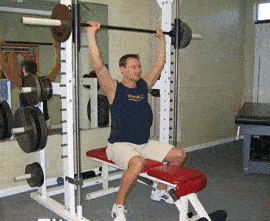
Training close to failure is enough
Scientific evidence tells us that, to gain muscle mass and strength, training must be intense enough. We agree that we should train with heavy loads and that the last few repetitions should be an effort. Now, this does not mean that reaching muscle failure is totally necessary.
A workout that is too easy or low intensity will not produce enough stimulus to force our body to get bigger. But pushing the body to exhaustion in each set will interfere with proper recovery and could cause our progress to regress. So, we can affirm that the ideal training consists of approaching muscle failure , but without reaching it completely in all sets. This will ensure sufficient stimulation without compromising muscle recovery. Let's see the strategy of approaching muscle failure with examples .
- We will first give the example that we are capable of doing 15 repetitions with one weight. When we carry out the set, we only do 8 repetitions and leave the other 7 to do (RIR 7). This set has not been effective, since we have moved too far from the limit or muscle failure. If we could still complete another 7 repetitions, it means that everything has been too easy for our body.
Note : RIR is a concept that refers to the number of repetitions that we could do, but do not do, in a set. For example, RIR 3 means that we leave 3 repetitions undone.
- Now, suppose we complete all 15 repetitions; that is, all the repetitions we could do. We arrived at the absolute failure. Of course, this set will have been effective, but it will take longer to recover because we will have pushed our muscles to the limit of their strength.
- The third case, and the most favorable, would be to complete 13 repetitions. We will be 2 repetitions away from muscle failure (RIR 2). In the last repetitions, the load will have weighed us down a lot, enough to cause a good stimulus to the muscle. However, we have not reached complete exhaustion, since we did not do the 15 total repetitions that we could.
Staying very far away from failure (Ex.: RIR 7) | Approaching failure (Ex.: RIR 2) | Reaching failure (RIR 0) |
| Stimulus: 20% | Stimulus: 70% | Stimulus: 90% |
| Recovery: 80% | Recovery: 30% | Recovery: 10% |
The table shown is only an assumption, but it helps you see the balance that we are trying to explain to you. If we move away from failure in the set, we will have a great capacity for recovery, but the muscle stimulation will be very poor. If we get close to failure (for example, leaving 2 repetitions in the tank), we will get a good stimulus and some recovery response. If we reach absolute muscle failure, the greatest stimulus will occur because the muscle will have reached the limit of its strength, but at the cost of putting at risk the ability to recover from training.
If you want your body to get bigger and stronger, you have to give it a reason for it. Simply put, your body won't make new muscle or gain strength if you don't give it an intense enough workout. Doing sets that are too easy, where the last few reps cost nothing, will bring you very little gain. But pushing every set to the limit will hurt you both physically and mentally and could slow down or even set you back in your progress. So, look for balance .
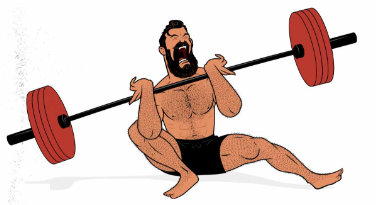
How to use muscle failure training intelligently?
The point is that failure can have its place in training and it can be interesting to use it at certain times, but you have to know how to do it . We must differentiate between using this strategy in strength training or hypertrophy training.
- Strength: In this case, there are not too many complications, since strength routines are strict plans where muscle failure is rarely reached. In 5x5, 5 3 1 or Smolov type routines , you have to follow what is prescribed in the training. Typically, these routines start very far from muscle failure. Failure is not very interesting for strength training, as it can cause us to stagnate quickly. Thus, failure days will be scheduled for specific sessions where we will look for a record of repetitions with a load.
- Hypertrophy: Training to failure in hypertrophy has more controversy, as it depends more on the personal preferences and sensations of the athletes. There are all kinds of opinions here, but we'll give you some general guidelines in a sensible way.
ORGANIZE TRAINING IN BLOCKS
When starting a new training routine, don't go to failure in the first few weeks. In a new bodybuilding routine, there will be a new movement pattern that you will have to get used to. So use the first week to test the loads without becoming exhausted. If you start away from failure, you will have more room for improvement .
As the weeks go by, you can lower the RIR of your sets to get closer and closer to your limits. The RIR is the number of repetitions we keep in the tank without failing. Each block will be one week.
| Block 1: Initiation week | RIR 5 |
| Block 2 | RIR 3 |
| Block 3 | RIR 1 |
| Block 4 | RIR 0 (failure) |
| Block 5 | RIR 0 (failure) |
| Block 6: Unload | RIR 5 |
As you see, we have 6 weeks of hypertrophy training. In the first block or week, we are with a RIR 5; We started very soft to get used to the weights. Blocks 2 and 3 are weeks where we lower the RIR to progressively get closer to failure. Then come blocks 4 and 5, which are peak weeks where we will use muscle failure. Finally, week 6 will be an unload and recovery week, so we will return to a RIR 5. Then we can restart the blocks.
You will be interested in:
This is a smart way to exercise your muscles, where we use muscle failure training only at certain times in the programming. Now, we'll look at ways to apply failure at certain times in a training session.

THE FAILURE IN THE MAIN SET
In the first method that we will explain, we are going to bring the muscle to failure only in the first working set of each exercise. This will be the main set. The following sets of the exercise will be a "back-off", where we will remove some of the load and get closer to failure, but without reaching it.
For example, we do a main bench press set of 10 repetitions with 75 kg reaching muscle failure. Afterwards, we could do 3 sets of 12 with 60 kg, keeping some repetitions in the tank.
Next, we do a 10-rep bicep curl main set with 40kg to failure. Afterwards, we could do 3 sets of 12 with 25 kg, keeping some repetitions in the tank.
We would do it this way with all the exercises in the session: 1 main set to failure followed by several assistance sets without failing. This is an effective way to reach muscle failure for hypertrophy. As we will only include one set taken to the limit for each exercise, we will have a good stimulus but we will not overexert ourselves.
THE FAILURE IN THE LAST SETS
Another effective system is to do the repetitions to failure only in the last set or the last two sets of an exercise. We will use the first sets of each exercise as approach work. Let's look at an example of muscle failure following this methodology for 4 sets of bench press:
- Approach set : 70 kg x 12 (we are approaching failure)
- Approach set : 75 kg x 8 (we are approaching failure)
- Set to failure : 80 kg x 10 (we reach failure)
- Set to failure : 90 kg x 4 (we reach failure)
In the event, we reached failure in the last two sets. We can also reach failure only in the last set. We will do the same with all the exercises that we are going to carry out in that training session. This way, not all of our sets will be to muscle failure; only some of them, so we can recover well from weight training.
THE FAILURE IN THE LAST EXERCISES
Another strategy is to do only some exercises to failure. The limit will not be reached in all the training exercises, only in some. Typically, basic or compound exercises will be done first, which are more complex movements where muscle failure would have a greater impact on the nervous system and muscle damage. For these basic exercises, we are going to train close to muscle failure, but without completely reaching it. The second half of the routine will be for analytical or isolation exercises. These are simpler movements for specific parts of the body. Failure in the analytical exercises will not have such a negative impact, so we will do a few sets until muscle failure in these movements.
Let's look at an example of this strategy for a muscle failure routine for pectorals and biceps:
Barbell bench press : 4 x 8 (RIR 2/RIR 3)
Dumbbell bench press : 4 x 10 (RIR 2/RIR 3)
Incline bench dumbbell flyes : approach + 2 sets to failure
Machine chest fly : approach + 2 sets to failure
Cable crossovers : approach + 2 sets to failure
Barbell biceps curl : 3 x 10 (RIR 2/RIR 3)
Seated biceps curl on inclined bench : approach + 2 sets to failure
Cable biceps curl : approach + 2 sets to failure
Did you understand the training style? We first do basic exercises leaving 2 or 3 repetitions far from failure (RIR 2 or RIR 3). Next, come the analytical exercises, where we do some approach sets and then 2 sets to muscle failure for each one.
Difference between technical and muscular failure
Another thing we would like to teach you is that there are several types of muscle failure. Something we have not seen yet is the technical failure . This is when we fail a set because our technique deteriorates or is going to deteriorate on the next repetition. It's interesting because, when technical failure occurs, the muscle has not necessarily been completely exhausted.
You will understand it better with an example. Imagine that you do 9 repetitions with perfect technique on the bench press. However, you could complete rep number 10 if you cheat a little; For example, if you lift your glutes off the bench a little and bounce the bar off your chest. By rep number 9, you would have reached technical failure, meaning you would not be able to complete rep 10 without doing the technique incorrectly.
Is it always advisable to stop the set when the technical failure has been reached? This depends! There are those who are for and against cheating to continue a set. It may be interesting to continue the set if you have experience and know how to do it. For example, if you reach technical failure in the military press, you can use a little momentum with your legs to do a few more repetitions. Or in barbell biceps curls, it is possible to use your legs lightly and some swing to continue doing repetitions. In exercises such as the bench press, going beyond technical failure can be dangerous, as we could injure our spine or tear a muscle. Therefore, applying these strategies to continue a set beyond failure depends on the exercise. But you should know that modifying the technique to do more repetitions will always carry a risk .
Intensity techniques
Many intensity techniques applied in bodybuilding are based on taking the sets beyond muscle failure and technical failure. The best known method is forced repetitions, where a partner or "spotter" helps the person complete more repetitions when she could no longer do it alone. This is the safest way to go beyond failure, since the correct technique can continue to be maintained thanks to a little help from your partner.
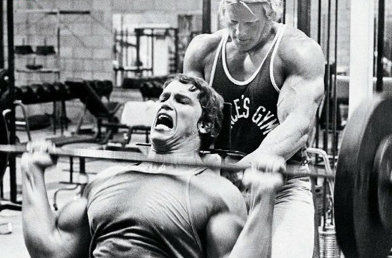
Techniques to go beyond failure :
- Forced repetitions.
- Cheated repetitions.
- Rest-Pause Method.
- The descending set o "Drop-set".
- Partial repetitions.
Know all these techniques:
You will also be interested in:
Frequent questions
You already know what it is and what it is for to achieve muscle failure, its benefits and contraindications . We finish by answering some frequently asked questions on this topic.
What exercises to reach muscle failure are recommended?
In theory, the ideal exercises for this are those that can be performed without posing excessive danger or high risk of injury. These will mostly be isolation exercises, on machines, pulleys, etc. Or also movements where we can leave the bar or dumbbells immediately without getting trapped in case of failure.
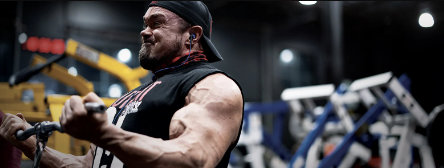
- Exercises that can be done on a pulley/cable : Back pulldown, bicep curls, triceps pushdowns, lateral and front raises, upright row...
- All exercises on a Multipower/Smith machine : Bench press, military press...
- Rows with a bar or dumbbell : When we can't handle the weight anymore, we will simply let it go.
- Deadlift : We can drop the bar very easily if we are not going to complete the repetition, although we must be careful not to risk making a bad movement.
- Barbell biceps curl and French press (or their dumbbell versions) .
- Convergent machines or with blocks .
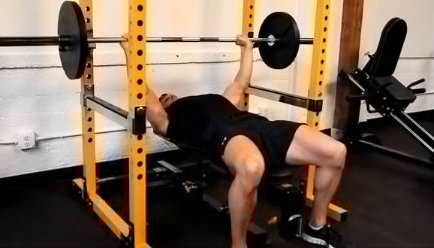
And in which exercises it is better not to risk it?
Well, basically, the bench press and the squat , but the military press also carries its risk (although we can release the bar more easily than in the bench press).
If you don't have a rack or bench with safety holders, never risk failure on the bench press or squat. Don't take risks if you don't have a trusted and experienced person who knows how to help you if you fail.
But even if you have the appropriate safety measures, it is always better not to go to the limit in these exercises. In the squat, for example, the technique tends to deform in the final repetitions because we lean too far forward or round our back. This could hurt our neck or lower back. Don't risk it!

Is it good to always reach muscle failure in the gym?
No. This strategy should be reserved only for some maximum effort sets or specific moments. It is much better to periodize training and not always go to failure.
Conclusion
Work to muscle failure yes or no? The answer should not be definitive and the athlete's recovery capacity, experience and the objectives sought at the moment must be taken into account.
- Reaching muscle failure is good for hypertrophy if it is done within a plan and not in all sets. It can be another very useful tool at certain times.
- Reaching muscle failure is bad when it is abused and interferes with the athlete's recovery. Overtraining at the limit can lead to fatigue (physical and mental), injuries, and slowed progress.
As with everything in the training world, it's up to you to test to find out what works for your body. You can use this explanation as a guide, but you have to see for yourself how much muscle failure you can tolerate and when it is best for you to use this strategy.



![LAS MEJORES MÁQUINAS DE MUSCULACIÓN PARA PRINCIPIANTES [GUÍA 2025]](/modules//smartblog/images/no-home-small.jpg)
![HOW TO BUILD A HOME GYM ON A BUDGET [2024 GUIDE]](/modules//smartblog/images/296-home-small.jpg)


